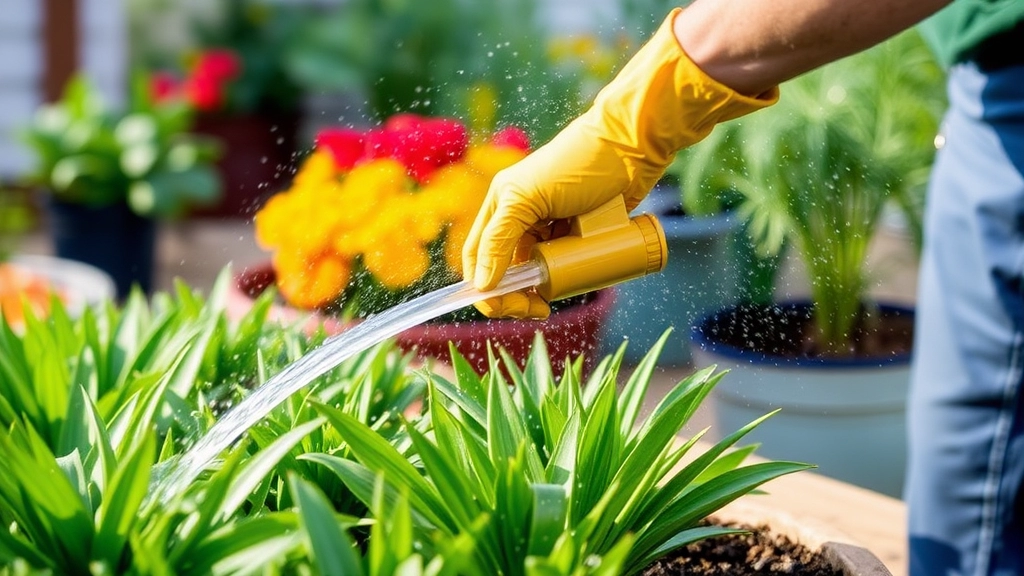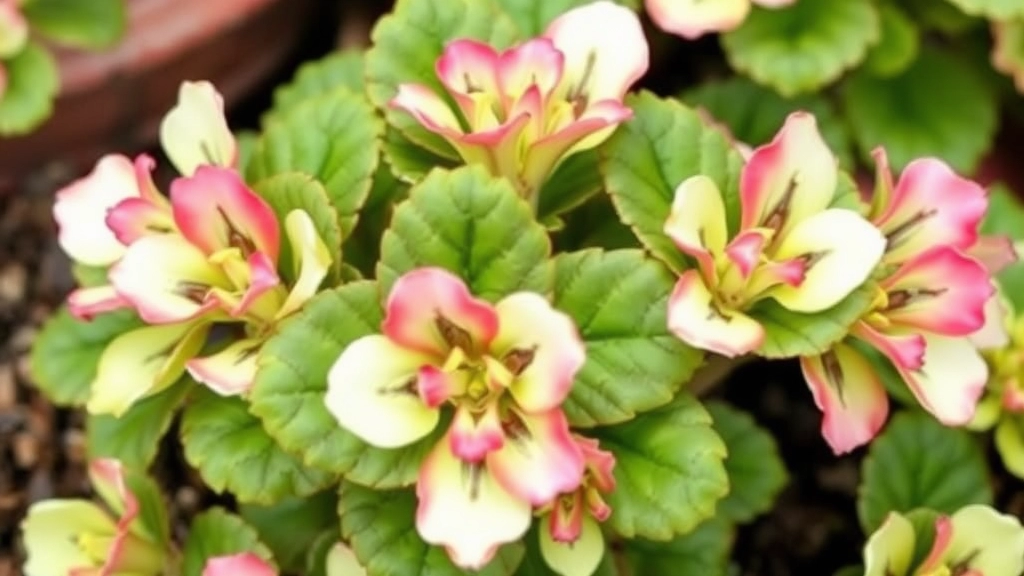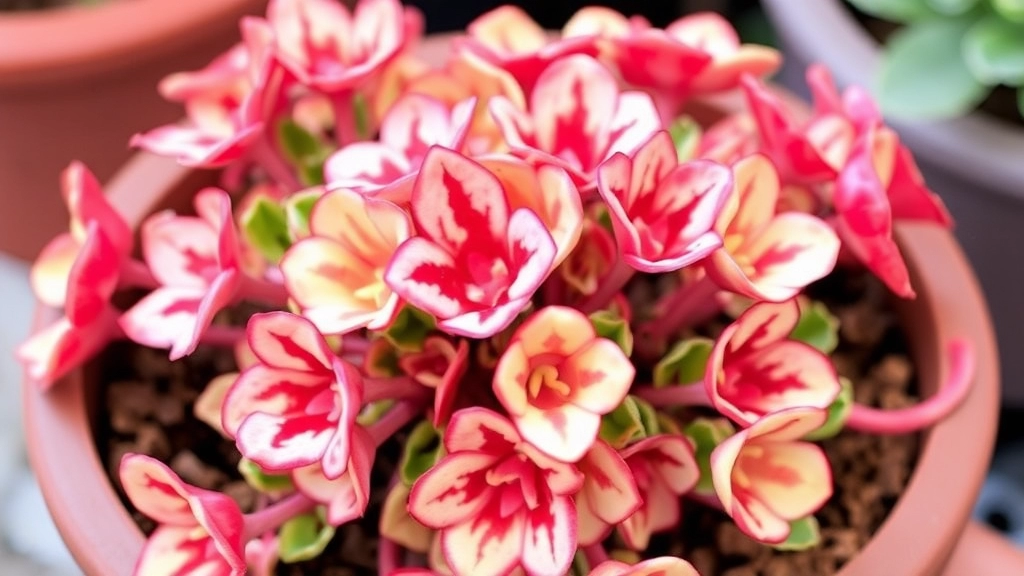Variegated Kalanchoe Care
When it comes to Variegated Kalanchoe care, getting the basics right can make all the difference. First off, these unique plants thrive in bright, indirect light. Too much direct sunlight can scorch the leaves, while too little light can dull their vibrant colours. So, placing them near a window with filtered light is ideal.
Watering practices are equally crucial. Overwatering is a common mistake, leading to root rot. I always let the soil dry out completely before watering again. Using a well-draining soil mix can help prevent water from sitting around the roots. Remember, these succulents prefer a bit of neglect over too much attention when it comes to watering.
Ideal Light Conditions for Variegated Kalanchoe
When it comes to growing variegated Kalanchoe, one of the most pressing concerns is ensuring it receives the right amount of light.
Why is Light Important?
The variegated Kalanchoe thrives on bright, indirect sunlight. Insufficient light can lead to leggy growth and diminished variegation, while too much direct sunlight can scorch its leaves.
Optimal Light Conditions:
- Bright Indirect Light: Place your plant near a window where it can soak up bright, filtered light. This mimics its natural habitat and encourages vibrant growth.
- Avoid Direct Sunlight: Direct exposure can cause leaf burn. If you notice the leaves turning brown or crispy, it’s a sign to move it to a shadier spot.
- Rotate Regularly: To ensure even growth, rotate your Kalanchoe every couple of weeks. This helps all sides of the plant receive adequate light.
- Supplement with Grow Lights: If natural light is limited, consider using grow lights. LED grow lights can effectively provide the necessary light spectrum for healthy growth.
For more detailed care instructions, check out our guide on how to care for a Kalanchoe succulent. Additionally, if you’re dealing with light-related issues, our article on fixing etiolated Kalanchoe Blossfeldiana offers valuable tips.
Watering Practices to Avoid Overwatering

So, you’ve got your variegated Kalanchoe, and you’re probably wondering, “How much water does this beauty really need?”
Overwatering is a common pitfall for many plant parents, and it can be a real killer for your Kalanchoe.
Here’s how to keep your plant happy and healthy:
1. Check the Soil Moisture
- Stick your finger in the soil about an inch deep. If it feels dry, it’s time to water.
- Use a moisture meter if you want to be extra sure. They’re handy and can give you a quick read.
2. Watering Schedule
- Less is more! Aim to water every 2-3 weeks, depending on the season.
- In winter, cut back even more. Your Kalanchoe is in a rest phase and doesn’t need as much moisture.
3. Watering Technique
- Water thoroughly but let it drain.
- Make sure the pot has drainage holes to prevent water from sitting at the bottom.
4. Signs of Overwatering
- Yellowing leaves are a clear sign. If you notice this, hold off on watering for a bit.
- Mushy stems? That’s a big red flag.
5. Adjust According to Environment
- Humidity matters! If you’re in a humid area, you might need to water less often.
- In a dry climate, your Kalanchoe might need a bit more love.
The Best Soil Mix for Variegated Kalanchoe Growth
When it comes to nurturing your variegated Kalanchoe, the right soil mix is crucial for its health and vibrancy. Many plant enthusiasts often wonder what type of soil will provide the best drainage and nutrients.
For variegated Kalanchoe, you should aim for a well-draining soil mix that allows air to circulate around the roots. Here’s what I recommend:
- Cactus Mix: A pre-made cactus or succulent mix is an excellent choice. These mixes are designed to drain quickly while retaining just enough moisture.
- Perlite or Pumice: Adding perlite or pumice to your soil mix can enhance drainage. Aim for a ratio of about 50% cactus mix and 50% perlite or pumice.
- Organic Matter: Incorporating a small amount of organic matter, like compost, can provide essential nutrients. However, be cautious not to overdo it, as too much can retain moisture.
- pH Level: Variegated Kalanchoe prefers a slightly acidic to neutral pH (around 6.0 to 7.0). You can test your soil mix to ensure it falls within this range.
Creating the ideal soil mix will set your variegated Kalanchoe on the path to thriving growth. For more detailed tips, you can check out our Best Soil for Kalanchoe Blossfeldiana Care Tips guide. Additionally, for a comprehensive understanding of Kalanchoe care, our Expert Tips on How to Care for a Kalanchoe Succulent might be helpful.
Temperature and Humidity Preferences

When it comes to caring for your variegated Kalanchoe, understanding its temperature and humidity preferences is crucial. Many plant owners worry about whether their home environment is suitable for these vibrant succulents.
Ideal Temperature Range
Variegated Kalanchoe thrives in a temperature range of 18°C to 24°C (65°F to 75°F).
- Avoid Extremes:
- Temperatures below 10°C (50°F) can stress the plant.
- High heat above 30°C (86°F) can lead to wilting.
- Indoor Conditions:
- Keep them away from drafts or direct air conditioning vents.
- A consistent environment is key for optimal growth.
Humidity Levels
Humidity plays a significant role in the health of your Kalanchoe.
- Low Humidity:
- Variegated Kalanchoe prefers low humidity levels, typically around 30% to 50%.
- Avoid Excess Moisture:
- High humidity can lead to fungal issues and rot.
- Ideal Placement:
- A well-ventilated area helps maintain the right humidity.
- Consider using a dehumidifier if you live in a particularly humid climate.
Tips for Maintaining Conditions
- Thermometers and Hygrometers:
- Invest in these tools to monitor your plant’s environment accurately.
- Seasonal Adjustments:
- Be mindful of seasonal changes and adjust your plant’s location accordingly.
## Fertilization Tips for Healthier Growth
When nurturing your variegated Kalanchoe, fertilization plays a crucial role in promoting vibrant foliage and robust growth. Many plant enthusiasts often wonder how to provide the right nutrients without overwhelming their plants.
### Understanding Nutrient Needs
Variegated Kalanchoe thrives on a balanced diet. Here are some key points to consider:
– **Type of Fertilizer**: Use a balanced, water-soluble fertilizer with an NPK ratio of 10-10-10 or 20-20-20. This ensures your plant receives equal parts nitrogen, phosphorus, and potassium.
– **Dilution**: Always dilute the fertilizer to half the recommended strength. This prevents the risk of nutrient burn, which can damage your plant.
– **Frequency**: Fertilize every 4-6 weeks during the growing season (spring and summer). In autumn and winter, reduce feeding to once every 8 weeks, or stop altogether, as the plant enters dormancy.
– **Organic Options**: If you prefer organic methods, consider using a liquid seaweed extract or compost tea. These options provide slow-release nutrients without the risk of chemical buildup.
### Signs of Nutrient Deficiency
Keep an eye out for signs that your Kalanchoe may need more nutrients:
– **Pale Leaves**: If the leaves lose their vibrant colour, it may indicate a lack of nitrogen.
– **Stunted Growth**: Slow growth can suggest a deficiency in phosphorus.
– **Leaf Drop**: Excessive leaf drop might signal an imbalance in nutrient levels.
For more detailed guidance on Kalanchoe care, you can check out our [Kalanchoe Mother of Thousands Care Guide](https://planthq.org/kalanchoe-mother-of-thousands-care-guide-tips-techniques/) and [Kalanchoe Beharensis Care Tips](https://planthq.org/care-tips-for-kalanchoe-beharensis-cv-fang-succulent/). These resources provide additional insights and techniques to keep your plants thriving.
How to Propagate Variegated Kalanchoe Successfully

So, you’ve got a lovely variegated Kalanchoe and you’re thinking, “How can I get more of these beauties?”
Propagation is a fantastic way to expand your collection or share with friends.
Here’s how to do it like a pro:
- Choose the Right Time
- Spring or early summer is ideal.
- The plant is in its growth phase, making it easier to root.
- Select Healthy Leaves or Stems
- Look for plump, healthy leaves or stems.
- Avoid any that are yellowing or damaged.
- Cutting Technique
- Use a clean, sharp knife or scissors.
- Cut a leaf or stem about 4-6 inches long.
- Let it sit for a day or two to callous over. This helps prevent rot.
- Prepare Your Soil
- A well-draining soil mix is key.
- You can use a cactus mix or create your own with potting soil and sand.
- Planting the Cuttings
- Stick the calloused end of the cutting into the soil.
- Water lightly, just enough to settle the soil around it.
- Create the Right Environment
- Place the pot in bright, indirect light.
- Keep it warm and avoid direct sunlight initially.
- Watering Routine
- Water sparingly; let the soil dry out between waterings.
- Too much moisture can cause the cuttings to rot.
- Patience is Key
- Roots should start forming in a few weeks.
- You’ll know it’s ready when you see new growth.
Propagation can be so rewarding, and before you know it, you’ll have a mini jungle of variegated Kalanchoe!
Common Pests and Diseases to Watch Out For
As we delve deeper into caring for your variegated Kalanchoe, it’s crucial to address the potential threats that can hinder its growth. Understanding common pests and diseases is key to maintaining a healthy plant.
FAQs on Variegated Kalanchoe Care
How often should I water my variegated Kalanchoe?
It’s best to water your variegated Kalanchoe every 2-3 weeks. During the winter months, you should reduce the frequency even further as the plant enters a rest phase.
What are the signs of overwatering my Kalanchoe?
Signs of overwatering include yellowing leaves and mushy stems. If you notice these symptoms, hold off on watering for a while.
What is the ideal temperature range for variegated Kalanchoe?
Variegated Kalanchoe thrives in temperatures between 18°C to 24°C (65°F to 75°F). Avoid exposing the plant to temperatures below 10°C (50°F) or above 30°C (86°F).
How can I ensure proper humidity levels for my Kalanchoe?
Variegated Kalanchoe prefers low humidity levels, around 30% to 50%. High humidity can lead to fungal issues and rot, so it’s crucial to maintain a well-ventilated environment.
What is the best way to propagate variegated Kalanchoe?
Propagation is best done in spring or early summer. Use a clean, sharp knife to cut a healthy leaf or stem, let it callous over for a day or two, and then plant it in well-draining soil. Keep the soil lightly moist and place the pot in bright, indirect light.
How do I know when my propagated Kalanchoe is ready?
You’ll know the propagation is successful when you see new growth. This usually happens within a few weeks as roots begin to form.
What type of soil is best for variegated Kalanchoe?
A well-draining soil mix is essential. You can use a cactus mix or create your own by combining potting soil with sand.
Where should I place my Kalanchoe indoors?
Place your Kalanchoe in a location with bright, indirect light. Avoid areas with drafts or direct air conditioning vents to maintain a consistent environment.
How can I monitor the environment for my Kalanchoe?
Invest in thermometers and hygrometers to accurately monitor the temperature and humidity levels around your plant. Adjust its location based on seasonal changes to maintain optimal conditions.
What should I do if my Kalanchoe starts wilting due to high heat?
If your Kalanchoe starts wilting due to high heat, move it to a cooler area with indirect light and ensure it’s not exposed to temperatures above 30°C (86°F). Water it lightly if the soil is dry.
References
-
How to Grow Kalanchoe Indoors
-
Kalanchoe Plant Care – How To Grow A Kalanchoe
-
Kalanchoe: How to Grow and Care for Kalanchoe Plants
